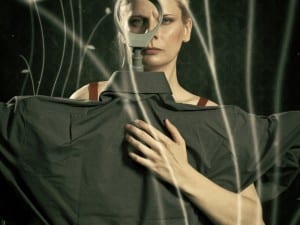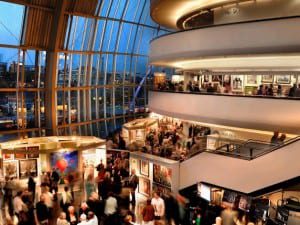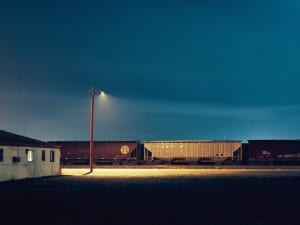It is hard to overestimate the enduring importance of attitudes to nature and ideas around the representation of landscape in Nordic culture and thinking. Landscape painting assumed particular importance in Denmarkaround the middle of the 19th century, when figures such as Johan Thomas Lundbye, Christen Købke and P.C. Skovgaard emerged as key figures, inspired by Caspar David Friedrich’s earlier mission to capture the sublime in nature.
When looking at Danish artist Per Bak Jensen’s work in the exhibition Near and Far: Landscape Photographs by Per Bak Jensen, curated by Barry Phipps – particularly the monolithic rocks and icebergs in Greenland – it is tempting to draw a parallel with Nordic landscape painting, and its evolution from the heroic, romantic wildernesses of the mid 1800s to the dreamy, inward-looking mental landscapes of the turn of the century. However, there is something altogether more intriguing about the way Bak Jensen uses the camera lens to impose an order on the landscape, the precise way the subject is framed, the stillness of the image and the interplay between horizontal and vertical planes.
For Romantic artists such as Friedrich, human presence ultimately remains peripheral to the elemental forces of nature, as if mankind is but a silent, meditative witness to nature’s unfolding mysteries. In Bak Jensen’s work, the artist appears to move stealthily through these natural and man-made landscapes, with a remarkable ability to astutely read the contours, shapes and forms as encountered. His photographs have a highly considered, geometric and sculptural quality, most notably Wandering Rock, in which the scale and central positioning of the rock in a placid ocean demands the viewer’s attention, then draws the eye in such a way that the moist green algae on the surface of the rock becomes iridescent and assumes a somewhat magical glow.
In his indefatigable search for new forms of photographic expression, Bak Jensen has been a prolific artist, establishing him as one of the most important contemporary art photographers in Scandinavia. He was recently described by Liz Wells as “seeking the in-between, and the unexpected”, and as being an artist preoccupied with the visual and symbolic effect of objects in the landscape, whether natural or subject to human intervention.
Although many of his pictures can undoubtedly be described as beautiful and harmonious, at least in a formal sense, there is a noticeable absence of romanticism, and a certain obsessive precision and coolness of approach that one might more readily associate with the Düsseldorf School. Bak Jensen’s art is the result of long periods of close observation and reflection, using the camera to hint at unseen relationships within the image and inviting the viewer to attempt to solve the puzzle of how reality is constructed.
Bak Jensen describes the motivation behind his work in terms reminiscent of Roland Barthes’ comments on photographic allure and meaning in Camera Lucida: “From when I first picked up a camera, as a child, to now, photography has been the way that I make contact with and try to make sense of the external world. In a way, I’m searching for the intangible, the unattainable, something that lies just beyond the immediately visible, but something that I take to be reality. It’s about my relationship to the world as I experience it”.
Bak Jensen professes to adopt exactly the same approach whether he is photographing in Greenland, a wood in Germany or an unpromising industrial location on the outskirts of Copenhagen. For the artist, it is about looking for the signs in the world that unlock the truth of reality. These signs may be less obvious in man-made environments, but they are there. In the photograph Snowfield, the hard-edged snow-covered trunk of an ancient tree imposes its monolithic presence in the foreground, with the soft furrows of a ploughed field receding into the distance. In Seamark, a meteorological antenna harshly dissects an otherwise serene Arctic vista of rocks, ice and clouds.
One senses that the artist is receptive to the flow of new shapes, textures and forms, as they present themselves, but how the images are composed always remains a conscious process. When Bak Jensen notices particular relationships or visual phenomena in the landscape that seem to have an enhanced meaning, he uses his camera to bring them into frame, to draw attention to them. The artist says that he takes many pictures, but not too many of the same subject, and apart from a little touching up and fine finishing in the studio he does not manipulate the photographs after the event. His aim is to capture the being of places, without overemphasising their metaphorical presence or imposing any particular ideological perspective.
This perhaps differentiates Bak Jensen’s approach from that which might have been taken by a landscape painter or conceptual artist, and it roots his practice more specifically in documentary photography. Photography is the artist’s chosen medium. It enables him to observe and record faithfully what he sees, but also to create harmony and to bring into sharp focus objects and relationships that might otherwise remain unseen. Through the camera lens there is a particular interplay between light and shadow, distance and proximity that transcends any fixed and literal reading of the landscape. It is about the exchange between reality, image and idea – and the potential nature holds for a greater truth than we are generally able to comprehend.
The pictorial quality of Bak Jensen’s work is seductive, but that belies the unusual and unsettling responses that certain images elicit in the viewer. Composition often appears more important than the subject, but there is something in Bak Jensen’s attention to detail and singular view of the world that is paradoxical and draws us in further. It is a photography that does not merely rely on the capacity of the medium to evoke aesthetic experience, but also stresses the idea or concept behind the image.
Near and Far: Landscape Photographs by Per Bak Jensen (Curated by Barry Phipps, University of Cambridge), 02/05/2012 until 11/05/2012, 12 Star Gallery, Europa House, London. The exhibition is currently on show at Churchill College, The University of Cambridge until 21/06/2012. www.chu.cam.ac.uk / www.europe.org.uk/12star
Credits:
1. Seamark (2006)
2. The Door (2007)
3. Wandering Rock (2008)
4. Snowfield (2010)
All images courtesy the artist
Text: David Drake




